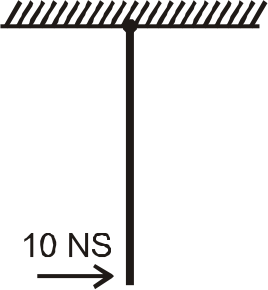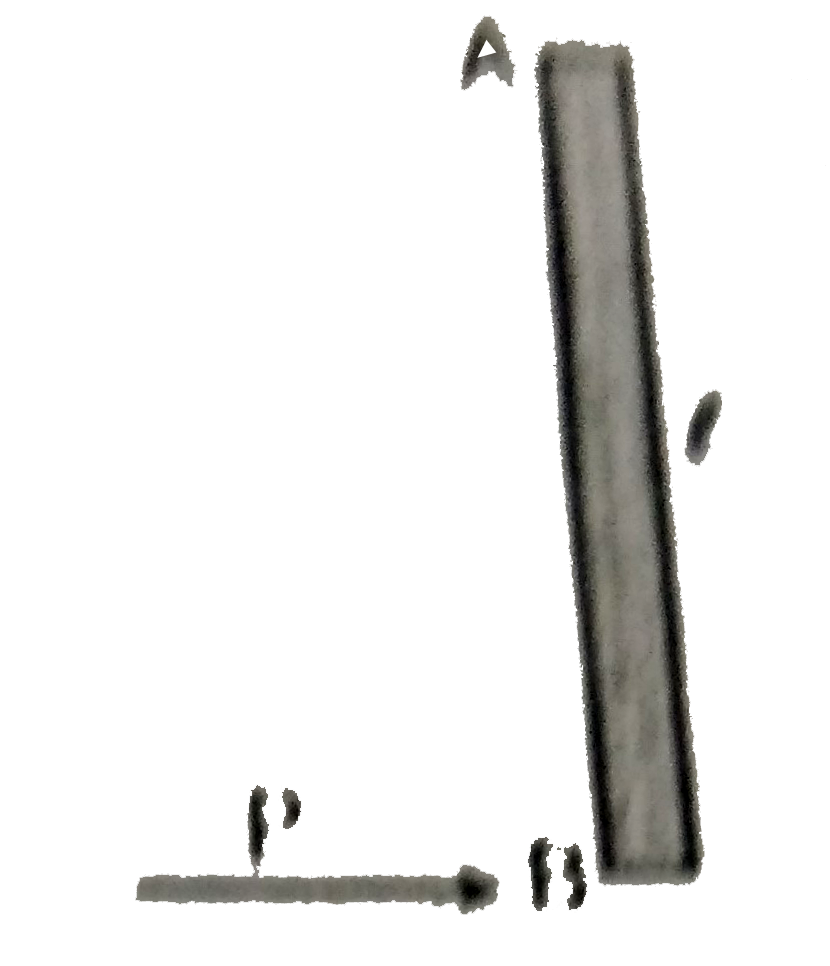A thin rod of mass m and length l is free to rotate on a smooth horizontal plane about its one fixed end. When it is at rest, it receives a horizontal impulse J at its other end, at angle of 37∘ with the length. Choose incorrect option immediately after impact:
Angular momentum of the rod about fixed axis of rotation is 0.6Jl
Angular velocity of the rod fixed of rotation is 1.8Jml
Kinetic energy of the rod is 0.2J2m
Linear velocity of the centre of mass of the rod is 910Jm
The correct Answer is:C
To solve the problem, we need to analyze the situation step by step.
Step 1: Break down the impulse into components
The impulse J is applied at an angle of 37∘ with respect to the length of the rod. We can resolve this impulse into two components:
- The horizontal component: Jx=Jcos(37∘)
- The vertical component: Jy=Jsin(37∘)
Using the trigonometric values:
- cos(37∘)=45
- sin(37∘)=35
Thus, we have:
- Jx=J⋅45
- Jy=J⋅35
Step 2: Calculate the angular impulse
The angular impulse ΔL about the fixed end of the rod can be calculated using the formula:
ΔL=r⋅Jy
where r is the length of the rod l and Jy is the vertical component of the impulse.
Substituting the values:
ΔL=l⋅J⋅35
Step 3: Calculate the moment of inertia
The moment of inertia I of a thin rod about one end is given by:
I=13ml2
Step 4: Relate angular impulse to angular momentum
Since the rod was initially at rest, the change in angular momentum is equal to the angular impulse:
ΔL=Iω
where ω is the angular velocity after the impulse.
Substituting the values:
l⋅J⋅35=13ml2⋅ω
Step 5: Solve for angular velocity ω
Rearranging the equation to find ω:
ω=3J5m⋅1l
Step 6: Calculate the linear velocity of the center of mass
The linear velocity vcm of the center of mass of the rod (which is at a distance l2 from the fixed end) can be calculated as:
vcm=ω⋅l2
Substituting for ω:
vcm=(3J5m⋅1l)⋅l2=3J10m
Step 7: Determine incorrect statement
Now we can analyze the statements provided in the question. The correct calculations lead us to the conclusion that the linear velocity of the center of mass is 3J10m and the angular velocity is 3J5ml. Any statement that contradicts these results would be incorrect.
The impulse J is applied at an angle of 37∘ with respect to the length of the rod. We can resolve this impulse into two components:
- The horizontal component: Jx=Jcos(37∘)
- The vertical component: Jy=Jsin(37∘)
- cos(37∘)=45
- sin(37∘)=35
- Jx=J⋅45
- Jy=J⋅35
The angular impulse ΔL about the fixed end of the rod can be calculated using the formula:
ΔL=r⋅Jy
where r is the length of the rod l and Jy is the vertical component of the impulse.
ΔL=l⋅J⋅35
The moment of inertia I of a thin rod about one end is given by:
I=13ml2
Since the rod was initially at rest, the change in angular momentum is equal to the angular impulse:
ΔL=Iω
where ω is the angular velocity after the impulse.
l⋅J⋅35=13ml2⋅ω
Rearranging the equation to find ω:
ω=3J5m⋅1l
The linear velocity vcm of the center of mass of the rod (which is at a distance l2 from the fixed end) can be calculated as:
vcm=ω⋅l2
Substituting for ω:
vcm=(3J5m⋅1l)⋅l2=3J10m
Now we can analyze the statements provided in the question. The correct calculations lead us to the conclusion that the linear velocity of the center of mass is 3J10m and the angular velocity is 3J5ml. Any statement that contradicts these results would be incorrect.
Similar Questions
A thin unifrom rod of mass m and length l is free to rotate about its upper end When it is at rest. It receives an impulse J as its lowest point, normal to its length immediately after impact.
View SolutionA thin bar of mass m and length l is free to rotate about a fixed horizontal axis through a point at its end.The bar is brought to a horizontal position. (θ=90∘) and then released. The angular velocity when it reaches the lowest point is
View SolutionA thin uniform rod of mass M and length L is free to rotate in vertical plane about a horizontal axis passing through one of its ends. The rod is released from horizontal position shown in the figure. Calculate the shear stress developed at the centre of the rod immediately after it is released. Cross sectional area of the rod is A. [For calculation of moment of inertia you can treat it to very thin]

View SolutionA thin uniform straight rod of mass 2 kg and length 1 m is free to rotate about its upper end. When at rest it receives an impulsive blow of 10 Ns at its lowest point, normal to its length as shown in figure. The kinetic energy of rod just after impact is

View SolutionA uniform rod of mass m and length L is free to rotate in the vertical plane about a horizontal axis passing through its end. The rod initially in horizontal position is released. The initial angular acceleration of the rod is:

View SolutionA rod AB of mass m and length L is rotating in horizontal plane about one of its ends which is pivoted. The constant angular speed with which the rod is rotating is ω. The force applied on the rod by the pivot is
View SolutionA uniform rod AB of mass m and length l at rest on a smooth horizontal surface . An impulse P is applied to the end B. The time taken by the rod to turn through a right angle is :

View SolutionA uniform rod AB of mass m and length l at rest on a smooth horizontal surface . An impulse P is applied to the end B. The time taken by the rod to turn through a right angle is :

View SolutionA uniform rod of mass m and length l rests on a smooth horizontal surface. One of the ends of the rod is struck in a horizontal direction at right angles to the rod. As a result the rod obtains velocity v0. Find the force with which one-half of the rod will act ont he other in the process of motion.
View SolutionA thin bar of mass M and length L is free to rotate about a fixed horizontal axis through a point at its end. The bar is brought to a horizontal position and then released. The axis is perpendicular to the rod. The angular velocity when it reaches the lowest point is
View Solution
